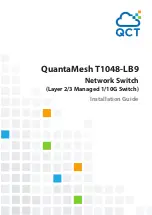
202
Dell PowerConnect 55xx Systems User Guide
IP Addressing
This section describes how to configure IP addresses on the switch, and
contains the following topics:
• IP Addressing Overview
• IPv4 Interface Parameters
• DHCP IPv4 Interface
• IPv4 Static Routing
• IPv6 Interfaces
• IPv6 Default Gateway
• ISATAP Tunnel
• IPv6 Neighbors
• IPv6 Routes Table
• Domain Name System
• Default Domain Names
• Host Name Mapping
• ARP
• UDP Relay
IP Addressing Overview
The device functions as an IPv6-compliant host, as well as an IPv4-host (also
known as dual stack). This enables device operation in a pure-IPv6 network,
as well as in a combined IPv4/IPv6 network.
Difference Between IPv4 and IPv6 Addressing
The primary difference between IPv4 to IPv6 is the length of network
addresses. IPv6 addresses are 128 bits, whereas IPv4 addresses are 32 bits.
Thus, IPv6 addresses enable the use of many more unique addresses.
The 128-bit IPv6 address format is divided into eight groups of four
hexadecimal digits. Abbreviation of this format by replacing a group of zeros
with double colons (::) is acceptable. IPv6 address representation can be
further simplified by suppressing the leading zeros.
Summary of Contents for POWERCONNECT 5524
Page 415: ...Dell PowerConnect 55xx Systems User Guide 415 ...
Page 728: ......
















































